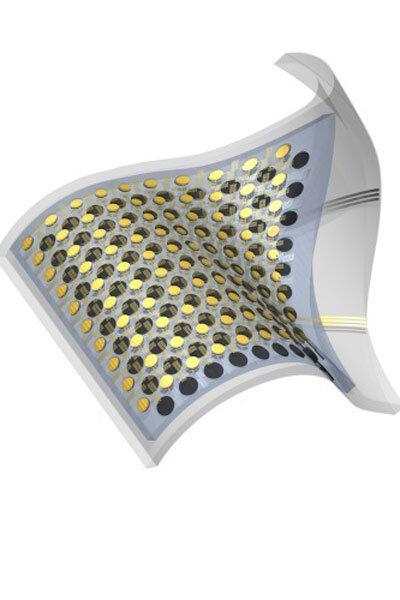Ultra-stretchy battery to power bionic life
Loading...
Our cyborg future may not be far off.
An ultra-stretchy battery could one day be used to power bionic eyeballs, brain-wave monitoring devices and robotic skins, new research suggests.
The new device, which embeds tiny lithium-based batteries in a silicone sheet, can stretch up to three times its initial length and could be recharged wirelessly, Yonggang Huang, study co-author and a mechanical engineer at Northwestern University, wrote to LiveScience in an email.
The new battery is described today (Feb. 26) in the journal Nature Communications.
Powering devices
For decades, science-fiction writers have envisioned dystopian worlds in which humans and machines are seamlessly integrated with bionic implants. But powering the cyborg future requires a way to conform power sources to these futuristic devices. [9 Cyborg Enhancements Available Right Now]
Other researchers have developed stretchy and paper-thin batteries before, but most didn't deform much or have the ability to recharge wirelessly, Huang wrote.
Toward that end, Huang and his colleagues embedded tiny lithium-ion batteries in a framework of conducting wires arranged in a repeating S-shaped pattern that, like a fractal, looks similar at several scales. The whole arrangement is printed onto a stretchable silicone sheet. The wires themselves are brittle, but uncoil like a spring, allowing the whole device to be flexible without forcing the delicate lithium-ion batteries to break.
To demonstrate that the concept actually worked, the team powered a red light-emitting diode (LED) while stretching and twisting the battery.
The researchers envision the battery being used for wearable gadgets, implantable brain-wave monitors, or other bionic devices.
While the new design is incredibly innovative, it wouldn't produce enough power to keep a laptop, or even a large light bulb, running, said Gao Liu, a chemist at Lawrence Berkeley National Laboratory who is developing stretchable batteries for transportation systems, but who was not involved in the study. That means it mainly would be useful for a few narrow applications, such as biological implants that don't require very much power, Liu said.
"It's for a niche market," Liu told LiveScience. "You really need to find a market where you don't really need much energy, but you need to deliver the energy on the spot, where you couldn't use a wire."
Follow LiveScience on Twitter @livescience. We're also on Facebook & Google+.
Copyright 2013 LiveScience, a TechMediaNetwork company. All rights reserved. This material may not be published, broadcast, rewritten or redistributed.







